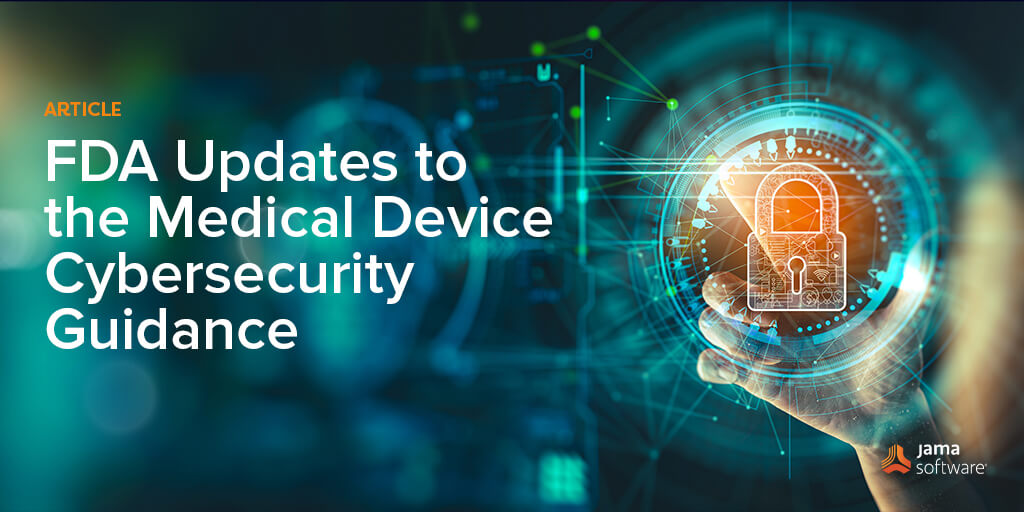FDA Updates to the Medical Device Cybersecurity Guidance
With an increase in connected medical devices, cybersecurity has become a hot topic for regulatory agencies. In the last few years, cybersecurity incidents have impacted medical devices and hospital networks disrupting the delivery of medical care and potentially putting patients at risk. Cybersecurity is the process of preventing unauthorized access, modification, misuse, denial of use, or simply the unauthorized use of information that is stored, accessed, or transferred from a product to an external recipient.
The focus on cybersecurity has led to several cybersecurity related guidance documents being published in the last few years. These guidance documents can be used by manufacturers to ensure that they are addressing cybersecurity in a way that meets the expectation of regulatory agencies. Some of the most important guidance documents available include:
- FDA – Content of Premarket Submissions for Management of Cybersecurity in Medical Devices
- FDA – Content of Post-market Submissions for Management of Cybersecurity in Medical Devices
- EU – MDCG 2019-16 Guidance on Cybersecurity for Medical Devices
- AAMI – TIR57: Principles for medical device security — Risk management
- AAMI – TIR97 Principles for medical device security— post-market risk management for device manufacturer
The FDA originally released the Content of Premarket Submissions for Management of Cybersecurity in Medical Devices guidance in 2014, which was a total of nine pages long and covered the elements of a cybersecurity process and the core functions of a cybersecurity framework (Identify, Protect, Detect, Respond, and Recover). The April 2022 update to the guidance is forty-nine pages and addresses cybersecurity as part of both the Quality Management System (QMS) and the Total Product Lifecycle (TPLC). According to the FDA, the changes in the guidance are intended to further emphasize the importance of ensuring that devices are designed securely and to be capable of mitigating emerging cybersecurity risks throughout the TPLC, as well as more clearly outline the FDA’s recommendations for premarket submission information to address cybersecurity concerns.
RELATED: 5 FBI Recommendations for Medical Device Cybersecurity
Keeping in mind that the changes to the guidance were to ensure that cybersecurity is addressed as part of the TPLC and the QMS, the following specific requirements have been added to the cybersecurity guidance:
- The guidance attempts to ensure that manufacturers are doing everything needed to design devices that are secured. The FDA now requires manufacturers to implement development processes that account for and address cybersecurity risks as part of design controls (21 CFR 820.30). This includes identification of security risks, the design requirements for how the risks will be controlled, and evidence that the controls are effective.
- The FDA recommends the implementation and adoption of a Secure Product Development Framework (SPDF) to address cybersecurity throughout the TPLC. An SPDF is a set of processes that reduce the number and severity of vulnerabilities in products throughout the device lifecycle; using an SPDF is one approach to help ensure that QSR requirements are met.
- The guidance includes requirements for labeling to provide information pertaining to the device’s cybersecurity controls, potential risks, and other relevant information
- The guidance requires a Security Risk Management Process (at an organizational level) to identify, assess and control security risks. The process for performing security risk management should be a distinct process from performing safety risk management as described in ISO 14971:2019. FDA recommends that manufacturers establish a security risk management process that encompasses design controls (21 CFR 820.30), validation of production processes (21 CFR 820.70), and corrective and preventive actions (21 CFR 820.100) to ensure both safety and security risks are adequately addressed. The Safety Risk Management process and the Security Risk Management Process, although separate, must be integrated, so that Security risks that can result in patient harm, once identified, can be evaluated and assessed for risk acceptability using the Safety Risk Management process. When a security risk or control measure could have a possible impact on patient safety or medical device effectiveness, then it should be included in the product risk assessment. Likewise, any risk control that could have an impact on security should be included in the security risk assessment.
- FDA recommends that threat modeling be performed throughout the design process to inform and support the risk analysis activities.
- The guidance requires that Cybersecurity risks posed by third party software components must be addressed and evidence be included in the Design History File.
- The guidance recommends the use of a Software Bill of Materials (SBOM) and specifies the information required to be contained in the SBOM, or as part of the documentation.
- The guidance specifies requirements for a Security Risk Management Plan and a Security Risk Management Report.
- The guidance requires vulnerability testing and penetration testing, along with verification of effectiveness of security controls.
- The guidance specifies a requirement for a Vulnerability Communication Plan, since cybersecurity risks evolve as technology evolves throughout a device’s TPLC, FDA recommends that manufacturers establish a plan for how they will identify and communicate vulnerabilities that are identified after releasing the device. The Vulnerability Communication Plan should also address periodic security testing.
RELATED: MDIC, HSCC Team Up to Establish Medical Device Security Benchmarks
In summary, the new FDA cybersecurity guidance raises the bar on how FDA expects industry to address cybersecurity throughout the TPLC and imposes requirements for additional deliverables, testing, and labeling.
- FDA Updates to the Medical Device Cybersecurity Guidance - October 20, 2022
- Top Signs Your Design Review Process Is Hurting Your Business - December 9, 2021
- Five Key Design Control Practices that Improve Compliance and Help Develop Better Products - October 7, 2021
